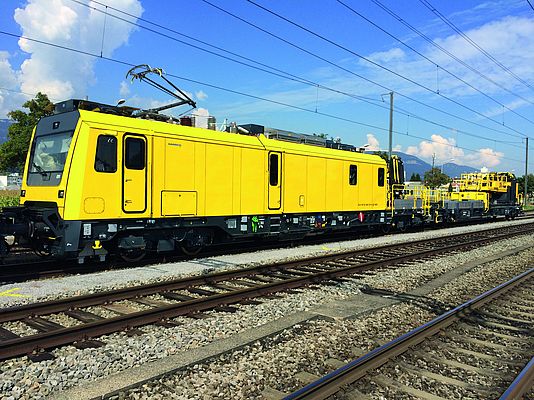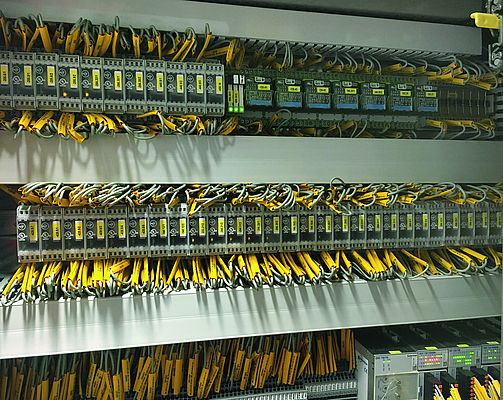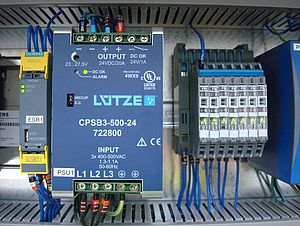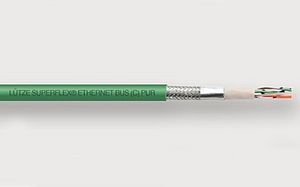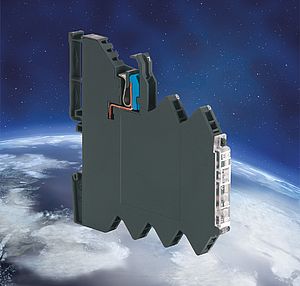In recent years, the demands made maintenance vehicles have changed dramatically. For instance, the amount of automated functions has increased significantly. Automatic train couplings and remote diagnosis are now standard at Harsco. Engineer Andreas Göbbels, project manager for maintenance vehicles for the Gotthard Base Tunnel at Harsco Rail Europe emphasizes: "Ultimately, it is important to harmonize the latest technology into a corresponding train control system whilst also taking all safety standards into account."
Modern Harsco maintenance vehicles use the so-called dual mode, a particularly sustainable technology, and can be operated both electrically or diesel-electrically, if, for instance, no electricity can be supplied via the overhead line. The responsible engineers are very proud of the fact that the train can be controlled not only from the driver's cab with the installed remote-control system, but also from various modules like the elevated work platform using a separate remote control.
The maintenance vehicles can be combined to create special maintenance trains that can be three or four hundred meters long in some cases. All wagons can communicate with each other and are connected with automatic couplings. During operations, it is possible to disconnect the train parts from one another, so they can work independently.
Harsco maintenance vehicles for the Gotthard Base Tunnel
The numbers of the Gotthard Base Tunnel are impressive: 57 kilometers of tunnel and 13 kilometers of open new sections add up to a total of 308 kilometers of tracks, 43 switches and 153 kilometers of overhead lines. But that is not all: 2,600 kilometers fibre optic cable, 3,200 kilometers of copper cable and 7,200 lamps present a huge challenge to the operator SBB with respect to the maintenance of important traffic connections on the European North-South axis.
Under a mountain range that is up to 2,450 meters thick, most work sites in the two driving tubes of the Gotthard Base Tunnel can only be reached for maintenance via the tracks. Lightweight commercial vehicles can only access the driving tubes via horizontal tunnels at two points.
The efficiency of a traffic route with this kind of investment sum can only be ensured if the necessary maintenance work is carried out quickly and at defined low-traffic times so that the approximately 165 trains that drive through the Gotthard Base Tunnel every day are not disrupted. Accordingly, the entire maintenance resources are only available during very short time windows at night at weekends. Harsco engineer Andreas Göbbels explains: "Due to the utilization of the tunnel, maintenance work can only be carried out in the three-night shifts starting on Saturday - this means all processes must run precisely and lots of tasks need to be completed in parallel and multifunctionally at various work sites. We can support the maintenance teams with our highly specialized vehicles.
In total, 31 Harsco maintenance vehicles were delivered to the SBB. Of this number, 13 are so-called basic vehicles that ensure safe operation in the tunnel. These are supplemented with highly specialized wagons like the module wagons or tank wagons. Each basic vehicle has a crane and an integrated workshop module as standard. Thought has also been given to the comfort and safety of the personnel. There is an air-conditioned compartment for the maintenance personnel with facilities such as a toilet and small tea kitchen.
A further problem for the maintenance work in the Gotthard Base Tunnel is the very high average temperatures of 35 - 40°C and the air turbulence. To contain these and the connected flying dust particles, and to create a safe work environment, Harsco Rail has developed the world's first mobile maintenance curtain (MET). This curtain separates one tunnel section almost completely from the rest of the tunnel tubes by placing the gate at the separating point and aligning it with millimeter precision using lasers. The spread arms of the MET ultimately connect with the adjustment rings installed in the tunnel wall.
Lütze as a partner to Harsco Rail
For years, Lütze Transportation has supplied solutions to Harsco for various projects including rail-compatible analogue-analogue converters, analogue limit value switches, various positively-driven relay components, diode modules and a USB charger system. In the latest case of the Harsco maintenance vehicles, a current monitoring system for AC 230 V consumers is realized with Lütze rail equipment. To this end, an analogue/analogue converter and an analogue limit value switch are combined.
As one of the first manufacturers, Lütze Transportation also supplies a rail-compatible USB charger that complies with EN 50155. This USB charging system comprises a DC/DC converter and the corresponding USB charger slot. The locomotive drivers can use this system to charge their mobile phones and tablet PCs comfortably and easily in the driver's cab of the maintenance vehicles. Manpower plans and schedules no longer need to be printed out and can be updated in real time.
Lütze Transportation USA has maintained a very successful partnership with Harsco Rail USA since 2000. The Lütze products that are currently being delivered in the third generation are customer-specific IP68-protected PLC control systems with integrated field level. They are used by Harsco USA with a self-developed software for the control system on the entire fleet of track construction and maintenance machines. The engineers of Harsco USA particularly appreciate the ruggedness and durability of the components. Other benefits of the Lütze rail equipment for the Harsco technicians are undoubtedly the very good diagnosis options for the connected periphery. Also, there are huge benefits connected to the easy replacement of Lütze components, e.g. according to the specifications of certain maintenance cycles.
Future projects with Lütze Transportation are waiting in the wings. Harsco Rail develops and manufactures a fleet of overhead line vehicles for the Swiss rail network of the SBB.



